Content
- Age values of normal heart rate in children at 10 years old
- The reasons for the development of sinus arrhythmia in a child
- Respiratory form
- Non-respiratory form
- Symptoms
- Child complaints about poor health
- ECG signs
- How is the diagnosis carried out, the survey plan
- Treatment of sinus arrhythmia in a child
- Preparations for children
- Amiodarone
- Riboxin
- Installing a pacemaker
- Folk remedies
- How is severe arrhythmia in children treated?
- Arrhythmia and sports
- Possible complications and prognosis
- Arrhythmia video
Sinus arrhythmia in a child aged 10 years Is a pathological condition of the cardiovascular system, in which there is a violation of the rhythm and frequency of heart contractions. In children with this disease, the release of blood by the heart muscle occurs after different periods of time, depending on physical activity, the impact of external and internal factors.
In this case, the ventricles and atria of the heart continue to function in a physiologically correct sequence without signs of disturbances. Sinus arrhythmia in children of this age group occurs due to the presence of concomitant diseases of the body, hereditary predisposition or structural features of cardio-vascular system.
Age values of normal heart rate in children at 10 years old
A healthy child who has no signs of sinus arrhythmia has a normal heart rate of 80 to 85 beats per minute. The measurement of this physiological indicator is carried out at the moment of physical calmness without stressing the heart and blood vessels of the child. A decrease or increase in heart rate indicates an abnormality in the heart rhythm.
The reasons for the development of sinus arrhythmia in a child
Sinus arrhythmia in a 10-year-old child is classified into 2 main forms. It is a respiratory and non-respiratory type of disease. These types of disturbances in the rhythmic work of the heart are formed under the influence of pathological and physiological reasons.
Respiratory form
A distinctive feature of the respiratory form of arrhythmia is that the development of this pathology is closely related to the functional the state of the child's bronchopulmonary tissue, smooth muscles and peripheral nerves that ensure the efficiency of organs breathing. The next inhalation of air dramatically increases the frequency of contractions of the heart muscle, and exhalation causes a decline in the activity of the heart.
The following causes of sinus arrhythmia with a respiratory form of manifestation, which occurs in children 10 years of age, are distinguished:
- the rapid onset of puberty, when the secretory activity of hormone-producing organs increases, and the child's body enters the next stage of physical development;
- overweight or morbid obesity;
- negative consequences of rickets, which was transferred in early childhood;
- complications of intracranial hypertension;
- encephalopathy;
- neurological disorders in which the functions of peripheral nerves are impaired, providing a stable contraction of the muscles of the chest;
- bronchial spasms caused by an acute form of an allergic reaction;
- emphysema of the lungs, which disrupts the stable functioning of the respiratory system, affecting the frequency of heart contractions.
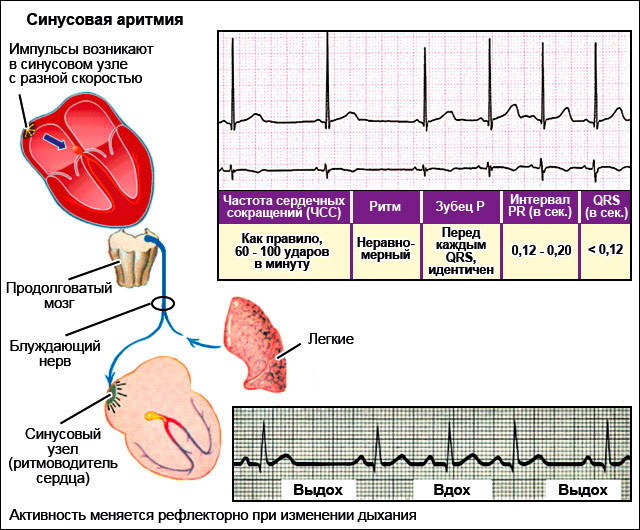
Physiological factors of sinus arrhythmia in children of the middle age group associated with the initial period of hormonal changes in their body, overweight, do not require the use of medicinal drugs.
Pathological causes of the respiratory form of the disease are eliminated by complex drug therapy. The main danger of this type of sinus arrhythmia is that the progression dysfunctional disorders in the work of the heart develops simultaneously with concomitant disease lungs and bronchi.
Non-respiratory form
Sinus arrhythmia of a non-respiratory form is a complication of previous diseases of the body, or is caused by currently present diseases of the heart, blood vessels, internal organs and life support systems of the body child. In this case, this type of pathology manifests itself constantly or paroxysmal.
Sinus arrhythmia of a non-respiratory form is caused by the following pathological factors:
- negative heredity, when a child has acquired a tendency to develop this disease along with genetic information from the father or mother;
- a previous illness of a viral or bacterial nature, which was accompanied by a long maintaining a high body temperature, attacks of fever, extensive intoxication of the body with foods vital signs of infection;
- severe violations of the water-electrolyte balance (the effect of this causative factor occurs in children who do not follow the optimal drinking regimen, lack mineral components);
- inflammation of the tissues of the heart of an infectious nature of origin;
- atrial fibrillation of the heart muscle;
- the presence of extrasystolic arrhythmia;
- congenital heart defects that have arisen due to abnormalities in the intrauterine development of the fetus;
- the consequences of neurocirculatory dystonia, when the child's blood vessels expand the lumen of their walls too slowly, making it difficult to provide the heart tissues, a sufficient amount of air (the influence of this negative factor leads to oxygen starvation of the heart muscle with the gradual development of ischemic disease);
- heart block;
- damage to the structure of the valves, which are caused by rheumatism, bacterial, fungal or viral infection of the heart muscle and coronary vessels.

Sinus arrhythmia in a 10-year-old child with a non-respiratory form of manifestation differs in that the pacemaker maintains the correct frequency contractions of the heart, but under the influence of negative factors, the work of its conducting system is disrupted, the intracellular tissue metabolism.
The danger of this ailment lies in the high probability of developing severe complications for the entire cardiovascular system of the child. Children with sinus arrhythmia, which manifests itself in a non-respiratory form, are registered with a cardiologist.
Symptoms
The appearance of sinus arrhythmia can be accompanied by acute symptoms in the form of an attack that continues several minutes, and then disappears, or it is expressed by a deterioration in the general well-being of the child, physical weakness. In medical practice, there are cases when the signs of this pathology are diagnosed only by the results of an electrocardiogram. At the same time, the child's well-being remains satisfactory.
Child complaints about poor health
By the nature of the manifestation of symptoms, sinus arrhythmia is classified into moderate and severe. In the first case, there are no complaints from the children about the deterioration of health.
Severe sinus arrhythmia is accompanied by the following signs of a child's painful condition:
- deterioration in sleep;
- shortness of breath and complaints of shortness of breath, squeezing pain in the chest;
- poor appetite, or a complete refusal to eat;
- cyanosis of the lips and epithelial tissues located in the area of the triangle of the nose;
- dizziness and darkening in the eyes;
- sudden loss of consciousness, which occurs with a simultaneous violation of the heart rhythm;
- excessive pallor of the skin;
- fast fatiguability;
- lethargy and psycho-emotional depression;
- heart palpitations when, in fact, the child is in a state of physical rest.

The first signs of severe sinus arrhythmia in children 10 years old is a sharp decline in activity. The child stops playing games with his peers, avoids excessive physical activity, constantly tries to breathe in more air. During acute attacks of arrhythmia, the occurrence of panic attacks is not excluded, which are caused by fear of shortness of breath, severe dizziness and darkening in the eyes.
ECG signs
Sinus arrhythmia in a 10-year-old child is diagnosed using an electrocardiogram. This method of examination makes it possible to determine even a moderate form of this disease, when no complaints about a deterioration in well-being come from the child.
There are the following ECG signs of sinus arrhythmia in children of the appropriate age:
- irregular functional activity of the sinus node of the heart;
- alternation of time intervals associated with a sudden decrease, as well as an increase in heart rate;
- shortening the length of the R-R intervals at the time of an increase in the heart rate, as well as lengthening the R-R intervals at the time of a decrease in heart rate;
- the duration of fluctuations of the R-R intervals is higher than 0.10-0.15 units, and their appearance is directly related to the phases of inhalation and exhalation;
- the teeth related to the QRST complex do not show signs of modification;
- ECG intervals of the P-Q (T) group are constant;
- the P wave everywhere precedes the QRST complex.

Sinus arrhythmia in a child
These ECG signs are determined by a cardiologist in the process of decoding the results of the child's examination. Particular attention is paid to impulses in the CA-node of the heart muscle, which are always irregular and uneven in sinus arrhythmia.
How is the diagnosis carried out, the survey plan
The table below details the main methods for diagnosing sinus arrhythmia in pediatric patients.
| Survey methods | Characteristics of the diagnostic process |
| ECG | Electrocardiography is prescribed for all patients with signs of sinus arrhythmia. This diagnostic method displays the main symptoms of the pathological condition of the sinus node, as well as concomitant cardiac arrhythmias. The ECG is performed within 10-15 minutes. Deciphering of the research results is carried out by a cardiologist immediately after receiving data from an electrocardiograph. The average cost of a heart ECG in a private clinic is 750 rubles. In state polyclinics, an electrocardiogram of the heart is performed free of charge. |
| Ultrasound | Ultrasound examination of the heart muscle is an informational diagnostic method that simultaneously displays rhythm disturbances and also detects structural pathologies of this organ. Ultrasound is used as an additional and auxiliary method of examining children with signs of sinus arrhythmia. The average cost of this diagnostic method is 800 rubles. |
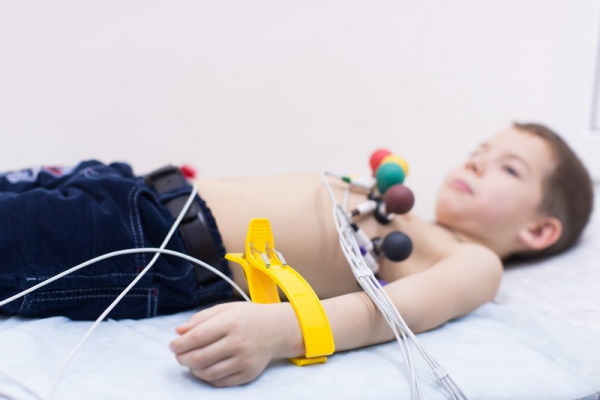
Children with non-respiratory sinus arrhythmia due to infectious inflammation the heart muscle, in addition, the donation of venous blood is prescribed to determine the type of bacterial or viral microorganisms.
Treatment of sinus arrhythmia in a child
Therapy of respiratory-type sinus arrhythmia, which is caused by non-pathological factors, does not require the use of drugs. In this case, the frequency of heart contractions and the stability of its rhythmic work are restored independently as the child develops and grows up. In such a situation, there is no threat to the health and life of children. Comprehensive treatment will be required for patients with non-respiratory sinus arrhythmia, which is provoked by concomitant diseases of the cardiovascular system.
Preparations for children
The treatment regimen for sinus arrhythmia in children 10 years old depends on the type of underlying pathology that caused the heart rhythm disturbance. The selection of drugs for drug therapy is complicated by the fact that most antiarrhythmic drugs have age restrictions on their use.
Amiodarone
Amiodarone is an antiarrhythmic drug that comes in a tablet form. The production of this drug is carried out by the Russian pharmaceutical company CJSC "Biocom". 1 tablet of this medication contains 200 mg of the active ingredient in the form of amiodarone hydrochloride.
The drug Amiodarone has antiangial properties, increases the functional activity of cardiomyocytes, ventricles and atria of the heart muscle. This drug is indicated for use for the complex treatment and prevention of arrhythmias, as well as complications that may arise due to this cardiac pathology.
For children, the dosage of the medication Amiodarone is from 2.5 to 10 mg of the active substance per day. The terms of treatment are determined individually, depending on the general condition of the child. The cardiological preparation is washed down with a glass of plain water without the addition of gases.
Treatment with Amiodarone can cause the following side effects:
- dyspnea;
- dry cough;
- headache;
- depression;
- neuropathy;
- deterioration in sleep;
- constipation or diarrhea;
- bronchial spasm;
- tremor of the upper limbs;
- increased intracranial pressure;
- auditory hallucinations.
The drug Amiodarone is prescribed with extreme caution to children aged 10 years. The therapeutic process should be supervised by a cardiologist. The average cost of this medication in pharmacies is 139 rubles.
Riboxin
Riboxin is a drug in the form of tablets, which belongs to the pharmacological group of metabolic agents. This drug improves intracellular metabolism in myocardial tissues, prevents degenerative changes in the structure of the heart muscle, eliminates the negative effects of hypoxia.
The active ingredient of this medication is inosine at a dosage of 200 mg in 1 table. The advantage of using Riboxin is that this agent helps to restore normal heart rate, and also prevents the development of severe complications in the form of coronary artery disease and heart failure.
For children aged 10 years, the dosage of Riboxin is selected individually by a cardiologist, but in the average can be 1 tablet, which is taken 1-3 times a day, depending on the severity of the pathological process. The duration of therapy is from 1 to 3 months.
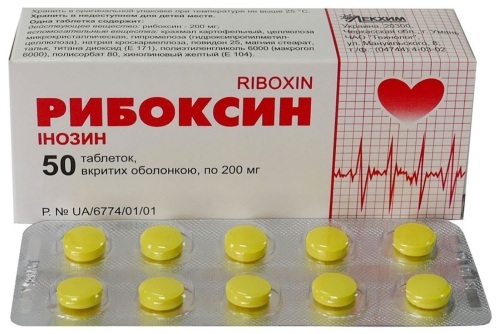
The most common side effects from taking Riboxin are allergic reactions and increased levels of uric acid in the systemic circulation. This drug is prescribed with extreme caution to patients with concomitant diseases of the body in the form of diabetes mellitus and renal failure. The average cost of the drug Riboxin is 41 rubles. for 50 tab.
Installing a pacemaker
Pacemaker implantation is indicated for children with severe forms of sinus arrhythmia, which cannot be eliminated with drugs. This therapeutic procedure is a minor surgery.
The implantation process is carried out under the influence of local anesthesia in compliance with the following algorithm of actions:
- In a sterile operating room, the child is anesthetized with the tissues in the upper chest area on the left collarbone side.
- An incision of the skin and subcutaneous fat is performed.
- The lateral vein of the upper limb is exposed.
- Under the control of X-ray equipment, one or several pacemaker electrodes are inserted into the cavity of the heart chamber through the venous vessel.
- With the help of a special device, the surgeon-cardiologist tests the threshold of stimulation of the heart muscle by electrical impulses, and also determines the level of its sensitivity.
- The electrodes are fixed inside the venous vessel.
- With the use of surgical instruments in the tissues of the subcutaneous tissue, a bed for the pacemaker is formed.
- The cardiac pacemaker is connected to the electrodes.
- Suturing of the wound surface is performed.
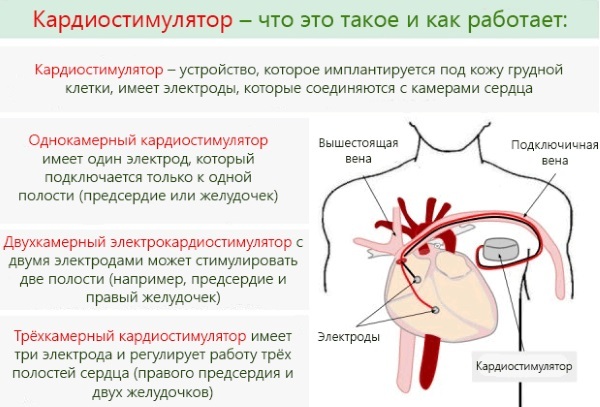 The subcutaneous pacemaker is placed in the upper part of the chest close to the collarbone. This device acts as a heart rate driver, preventing attacks of sinus arrhythmias.
The subcutaneous pacemaker is placed in the upper part of the chest close to the collarbone. This device acts as a heart rate driver, preventing attacks of sinus arrhythmias.
Folk remedies
Treatment of sinus arrhythmia in children aged 10 years with the use of alternative therapy is contraindicated.
How is severe arrhythmia in children treated?
Severe sinus arrhythmia in children, accompanied by frequent heart attacks, a significant deterioration in general well-being, is treated using the above means drug therapy.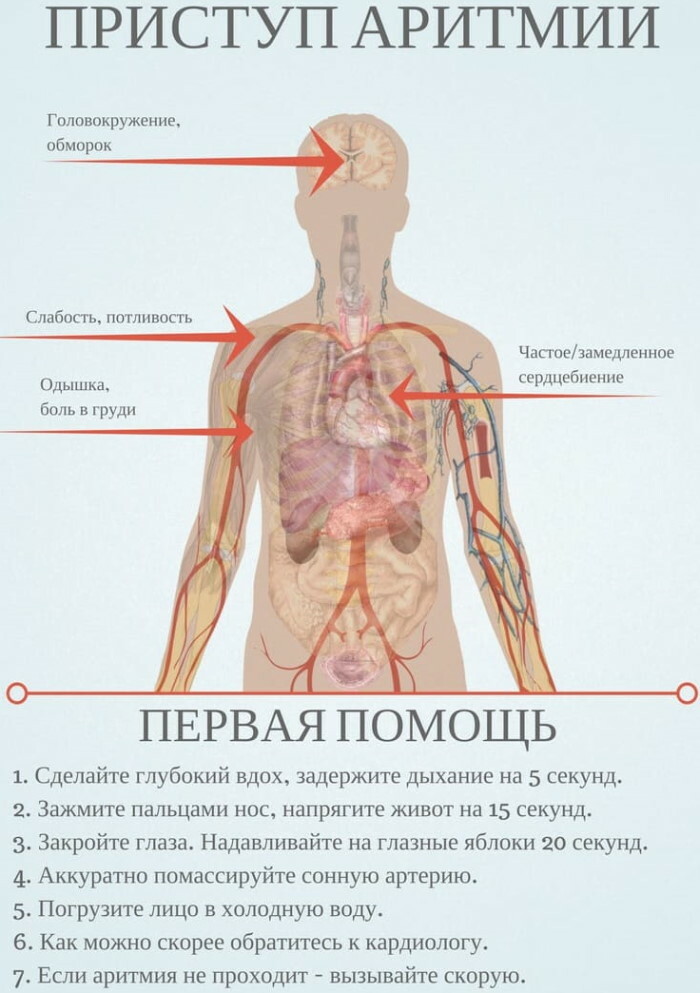
In combination with taking medications, the child must comply with dietary norms. Products containing an increased concentration of carbohydrates, as well as animal fats, are removed from the patient's diet. The daily menu of a child with severe sinus arrhythmia is dominated by fresh fruits, vegetables, lean meats and seafood.
Arrhythmia and sports
Sinus arrhythmia in a 10-year-old child is not a reason for a complete rejection of physical activity. This rule is valid only under the condition that disturbances in the frequency and rhythm of the contractile function of the heart are caused by the respiratory form of the disease with the simultaneous influence of physiological factors.
For example, if a child has a sharp change in hormonal levels before the onset of puberty. Children with this diagnosis can engage in sports clubs, but after preliminary consultation and a comprehensive examination by a cardiologist.
Children with mild respiratory sinus arrhythmias can do the same exercises as their peers. In this case, the child should regularly undergo planned electrocardiographic examinations.
The schedule of visits to the doctor is drawn up individually by the cardiologist with whom the patient is registered. Most often, preventive diagnostics is performed 1 time in 3 months, and its main purpose is control over the functional state of the heart, as well as timely prevention of cardiological complications.
Sports are contraindicated in children with severe sinus arrhythmia of a non-respiratory form of manifestation. Any physical activity that causes a sharp increase in heart rate is prohibited. In this case, playing sports is not only harmful, but also carries a danger of death.
For example, if the causes of a pathological condition of the heart are congenital malformations of its intrauterine development, violation of the structure of the valve apparatus, which arose due to complications of bacterial inflammation. For children with sinus arrhythmia of a non-respiratory form of manifestation, only walking in the fresh air is allowed, observing a measured pace of walking.
Possible complications and prognosis
In the absence of timely and adequate treatment in the future, sinus arrhythmia of a non-respiratory form of manifestation can cause the following complications:
- heart failure;
- coronary heart disease;
- damage to myocardial tissue;
- the onset of a lethal outcome.
Sinus arrhythmia in a child aged 10 years is considered a violation of the time interval between successive heart contractions. This pathology is classified into respiratory and non-respiratory forms of its manifestation. In the first case, arrhythmia is caused by a decrease or increase in the functional activity of the bronchopulmonary tissue.
The non-respiratory form of the disease occurs under the influence of concomitant cardiac diseases. Sinus arrhythmia in children is manifested by an increased heart rate, dizziness, shortness of breath, and a feeling of shortness of breath. Therapy of the pathological state of the child's cardiovascular system is aimed at eliminating the causes that provoked him, as well as normalizing the patient's pulse rate.
Arrhythmia video
What to do with arrhythmia:



